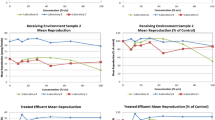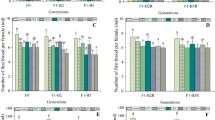Abstract
This paper reports the sensitivity ofCeriodaphnia dubia andDaphnia magna to ethanol, acetone, phenol, 4-chlorophenol, trichloromethane, diethanolamine and chlorobenzene, utilizing the three-brood test. The endpoints examined include survival at 48 h and at the end of the three-blood test, total progeny, number of broods, mean brood size, and dry weight. The final calculated result was the LC50/EC50 or that concentration of the test solution that reduced the variable in question to 50% of that of the controls. Total progeny, number of broods and mean brood size provided results of the same order of magnitude for each compound for a specific organism. Dry weight proved to be a poor endpoint. The response ofC. dubia to six compounds failed to provide a determinable EC50 due to a lack of significance of the regression equation. In the case ofD. magna, only five of the seven compounds provided a determinable result for dry weight. Compared to the results based on total progeny, number of broods and mean brood size, dry weight results in the absolute sense forD. magna were less sensitive for ethanol, phenol, 4-chlorophenol, more sensitive for trichloromethane, and about the same for diethanolamine as were the results for total progeny. For both cladocerans, progeny was the most sensitive endpoint for ethanol. For the other six compounds, survival at the end of the three-brood test provided LC50/EC50 results of the same order of magnitude as progeny, number of broods and mean brood size. Finally, it was of interest to discover the differences, if any, between these two cladocerans and place their response in relation to those other organisms that have been so tested. The three brood test results forD. magna prove this organism to be most sensitive to four out of the seven compounds.
Similar content being viewed by others
References
Berner DB (1986) Taxonomy ofCeriodaphnia (Crustacea: Cladocera) in U.S. Environmental Protection Agency culture. EPA 600/4-86/032, U.S. Environmental Protection Agency, Cincinnati, OH
Brooke LT, Call DJ, Geiger DL, Northcott CE (editors) (1984) Acute toxicity of organic chemicals to fathead minnow (Pimephales promelas). Vol. 1:35–38, 51–56
Brooks HL and Gates DE (1972) Insecticides: A handbook for use with insect control recommendations. C-376 Kansas State University, Manhattan, KS
Cowgill UM, Keating KI, Takahashi IT (1985) Fecundity and longevity ofCeriodaphnia dubia/affinis in relation to diet at two different temperatures. J Crus Biol5:420–429
Cowgill UM, Milazzo DP (1989) New approach to the seven-dayCeriodaphnia dubia test with additional comments pertaining to the same test forDaphnia magna. Bull Environ Contam Toxicol 42:749–753
Cowgill UM, Milazzo DP, Landenberger BD (1989) Toxicity of nine benchmark chemicals toSkeletonema costatum, a marine diatom. Environ Toxicol Chem 8:451–455
Cowgill UM, Milazzo DP, Meagher CK (1988) New diet forCeriodaphnia dubia. Bull Environ Contam Toxicol 43:304–309
Cowgill UM, Takahashi IT, Applegath SL (1985) A comparison of the effect of four benchmark chemicals onDaphnia magna andCeriodaphnia dubia-affinis tested at two different different temperatures. Environ Toxicol Chem 4:415–422
Gersich FM, Blanchard FA, Applegath SL, Park CN (1986) The precision of daphnid (Daphnia magna Straus 1820) static acute toxicity tests. Arch Environ Contam Toxicol 15:741–749
Gliwicz ZM (1990) Food thresholds and body size in cladocerans. Nature 343:638–640
Mayes MA, Alexander HC, Dill DC (1983) A study to assess the influence of age on the response of fathead minnow in static acute toxicity tests. Bull Environ Contam Toxicol 31:139–147
Mount DI, Norberg TJ (1984) A seven-day life-cycle cladoceran toxicity test. Environ Toxicol Chem 3:425–434
Provasoli L (1968) Media and prospects for the cultivation of marine algae. In Watanabe A and Hattorc A (eds) Cultures and collections of algae. Proceeding of a United States-Japan Conference held at Hakone 1966, pp 63–75
Provasoli L, Pintner IF (1953) Ecological implications of in vitro nutritional requirements of algal flagellates. Ann NY Acad Sci 56:839–851
SAS (1987) SAS/STAT Guide for personal computers, version 6th ed. SAS Institute Inc. Gary NC, pp 1–1028
Stephan CE (1977) Methods for calculating an LC50. In Mayer FL and Hamelink JL (eds) Aquatic toxicology and hazard assessment. ASTM STP 634:65–84
Takahashi IT, Cowgill UM, Murphy PG (1987) Comparison of ethanol toxicity toDaphnia magna andCeriodaphnia dubia tested at two different temperatures: static acute toxicity test results. Bull Environ Contam Toxicol 11:681–692
Weber CI et al (1989) Short-term methods for estimating the chronic toxicity of effluents and receiving waters to freshwater organisms. U.S. Environmental Protection Agency EPA/600/4-89/001 (2nd Ed) Cincinnati, OH
Author information
Authors and Affiliations
Rights and permissions
About this article
Cite this article
Cowgill, U.M., Milazzo, D.P. The Sensitivity ofCeriodaphnia dubia andDaphnia magna to seven chemicals utilizing the three-brood test. Arch. Environ. Contam. Toxicol. 20, 211–217 (1991). https://doi.org/10.1007/BF01055906
Received:
Revised:
Issue Date:
DOI: https://doi.org/10.1007/BF01055906




